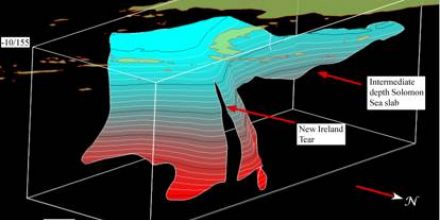Papua New Guinea and the Solomon Islands
A Virtual Earth Project by Tomas O'Kane, PhD Candidate
The Papua New Guinea and Solomon Islands region is located within the transition zone between SE Asia and the SW Pacific, one of the best-endowed metallogenic belts and most actively deforming areas on Earth. Interactions between the WNW-moving Pacific...
Project status
Content navigation
About

A Virtual Earth Project by Tomas O'Kane, PhD Candidate
The Papua New Guinea and Solomon Islands region is located within the transition zone between SE Asia and the SW Pacific, one of the best-endowed metallogenic belts and most actively deforming areas on Earth. Interactions between the WNW-moving Pacific Plate and the NNE-moving Australian Plate give rise to a complex convergent zone exhibiting numerous micro-plates, volcanic provinces, island arcs and some of the fastest relative plate motions on Earth.
Some of this complexity has been unraveled using earthquake hypocentre data to create a 3-D model of the Wadati-Benioff zone associated with the subduction of the Solomon Sea Plate at the New Britain Trench. We report the presence of a large aseismic zone, herein termed the New Ireland aseismic zone, located in the 'apex' of the subducting slab, the margins of which initially record a dip of 30 degrees, before steepening to over 75 degrees at depth. Steeper slab dips are seen both to the east and west of the slab apex, particularly the eastern section of the slab, which appears to have been overturned (i.e. dip exceeds 90 degrees).
In the light of this discovery, existing tectonic models must be reassessed. The 3-D geometry appears to require slab-tearing during roll-back, and by implication must have stranded formerly attached segments of the subduction zone. Alternative models for the aseismic zone, such as the subduction of an aseismic ridge, do not provide a satisfactory explanation for the apparent geometry (and the implied deformation) of the Solomon Sea slab. The roll-back and slab-tearing hypothesis is consistent with the current 3-D geometry and has significant ramifications for the tectonic evolution of the region.
